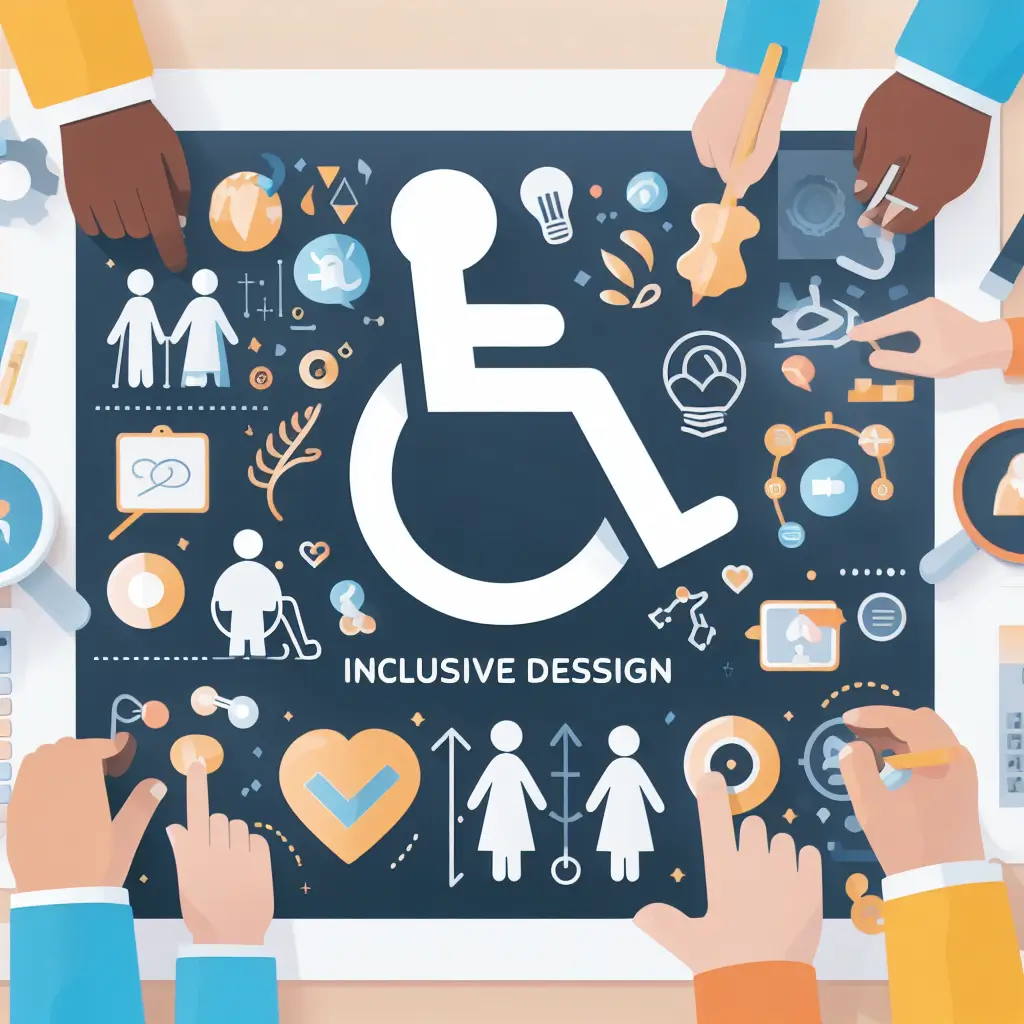Creating an inclusive website design is crucial for ensuring that all users, regardless of abilities, can access and use the content effectively. The impact of inclusive design on internet users’ experience, best practices, and tools cannot be overstated. By following accessibility guidelines such as color contrast and providing alternative text for images, websites can become more usable for everyone, including internet users. Inclusive design benefits individuals with disabilities and enhances the overall user experience for all internet users. This approach leads to a broader audience reach and fosters a positive brand image by focusing on accessible design, universal design, and web experience objectives.
Understanding Inclusive Design

Principles
Inclusive website design is guided by the principles of designing for all users, people, irrespective of their abilities. This means considering diverse needs and preferences of people when creating a website. Modern-day web design principles enable the creation of layered and appealing sites that cater to a wide range of people.
By incorporating these principles, designers ensure that individuals with varying abilities can interact with websites effectively. For instance, using clear and simple language benefits users with cognitive impairments, while providing text alternatives for non-text content helps those who use screen readers on a site. These considerations make the website more accessible to everyone.
Elements
The essential elements of an inclusive website encompass incorporating inclusive features in design elements to ensure usability for all users. This involves employing responsive layouts, ensuring proper color contrast, offering keyboard navigation options, providing alternative text for images, and enhancing the web experience. For example, using high color contrast on a site benefits individuals with visual impairments or color blindness by making content easier to read.
Moreover, utilizing scalable fonts on the site allows users to adjust the text size according to their preference or need without compromising readability or functionality. By integrating such elements into web design, it becomes possible to create a site where every user can engage with the content seamlessly.
Accessibility Needs
Understanding the accessibility needs of different users is crucial in designing an inclusive website. It involves addressing various impairments including visual, auditory, cognitive, motor, and site limitations encountered by different individuals. By prioritizing accessibility needs during web development, designers ensure that people with disabilities can navigate through websites effortlessly.
For instance,
- Providing transcripts or captions for audio and video content on a site caters to individuals who are deaf or hard-of-hearing.
- Implementing adjustable time limits on the site accommodates those who require more time due to cognitive challenges.
- Incorporating intuitive navigation aids site individuals with motor difficulties in maneuvering through web pages effectively.
Assistive Technology
Assistive technology plays a pivotal role in enabling access to websites for individuals with disabilities. Websites must be optimized for seamless integration with assistive devices like screen readers and magnifiers so that they can interpret information accurately from the site’s interface.
For example,
- Screen readers convert digital text into synthesized speech or braille output allowing visually impaired users to comprehend webpage contents.
- Magnification software assists those experiencing vision loss by enlarging on-screen content without sacrificing clarity on-site.
Importance of Inclusive Web Design
Business Implications
Inclusive website design positively impacts business success by expanding the customer base through accessible websites. When websites are designed with inclusivity in mind, they become more user-friendly for individuals with disabilities, ultimately attracting a wider audience. For instance, implementing features like alt text for images and keyboard navigation not only cater to those with disabilities but also enhance the overall user experience for all visitors on the site.
Moreover, prioritizing inclusive design helps businesses build a positive brand image on their site. By demonstrating a commitment to accessibility and inclusivity on their site, companies can create goodwill among customers and stakeholders. This fosters trust and loyalty as it shows that the brand values diversity and is dedicated to providing equal opportunities for everyone on site.
Social Benefits
One of the key benefits of inclusive web design is its role in promoting equal access to information and services online site. Through accessible websites, individuals with disabilities can navigate digital content seamlessly, ensuring they have equitable access to essential resources such as educational materials or employment opportunities.
Furthermore, inclusive design empowers individuals with disabilities by enabling them to participate more fully in various online activities on the site. For example, features like screen reader compatibility on a site allow visually impaired users to engage with web content effectively. This empowerment contributes significantly towards fostering a more inclusive and equitable digital society where everyone has an equal opportunity to engage in online interactions without barriers on site.
Legal Considerations
There are legal requirements governing website accessibility that make inclusive web design crucial for businesses. Compliance with accessibility standards and guidelines is not just good practice; it’s often mandatory for site accessibility under various laws such as the Americans with Disabilities Act (ADA) in the United States or the Web Content Accessibility Guidelines (WCAG). Non-compliance at the site may lead to legal consequences including lawsuits or fines.
Google’s emphasis on factors such as performance (speed), accessibility, best practices (design & code), SEO, and site underscores how inclusive design contributes directly toward creating an optimal on-page experience. By incorporating inclusive elements into their websites’ designs—such as clear navigation structures or high contrast color schemes—businesses can align themselves better with Google’s search algorithm criteria while simultaneously making their platforms more welcoming for diverse users.
Creating an All-Inclusive Website Experience
Creating personas is a crucial step in understanding the diverse user groups that interact with your website. By developing personas, designers can tailor the website design to meet specific user needs, ultimately enhancing the overall user experience.
For example, if a website caters to both young adults and elderly individuals, personas can be created for each group. The design team can then ensure that the website’s layout and functionality are adapted to suit the preferences and capabilities of these distinct user demographics.
Furthermore, personalized approaches based on personas allow for a more targeted and effective communication strategy. This ensures that users from different backgrounds or abilities feel seen and catered to when navigating through the digital space/site.
Essential Pillars of Inclusive Web Design

Diversity Embrace
Inclusive website design involves embracing diversity in all its forms to ensure that the website caters to a wide range of users. This means considering cultural, linguistic, and socio-economic differences when creating the website. For example, incorporating multilingual support on a site allows users from different linguistic backgrounds to access and understand the content seamlessly.
Designing inclusive websites also entails ensuring that the design resonates with diverse audiences. This can involve using imagery, colors, symbols, and site that are universally understood and accepted across various cultures. By acknowledging and celebrating diversity through design elements, websites can create a welcoming environment for all visitors.
In 2022, equity, inclusion, and diversity have become integral standards for successful sites. Websites that effectively embrace diversity in their design approach are more likely to attract and retain a broad user base due to their ability to connect with individuals from varying backgrounds.
- Multilingual support
- Universal design elements (imagery, colors)
- Celebrating diversity through inclusive design
Design Thinking
Applying design thinking principles is crucial in creating an inclusive web experience site. It involves empathizing with users from diverse backgrounds and understanding their unique needs on the site. By putting oneself in the shoes of different users during the design process, designers can gain valuable insights into how to make the website accessible and appealing to everyone.
Moreover, an iterative design process, focused on gathering user feedback and conducting thorough testing at each stage of development on the site ensures that any barriers or challenges faced by diverse users are identified early on. Microsoft’s inclusive design toolkit outlines a comprehensive methodology based on these principles for UX designers to site.
By integrating empathy-driven approaches into web designing processes, designers ensure inclusivity becomes an intrinsic part of their work culture on site.
Downside and Upside of Inclusivity
Design thinking involves a human-centered approach to problem-solving and innovation. Here are some additional points about design thinking:
- Iterative Process: Design thinking is an iterative process that involves constantly refining and improving ideas through feedback and testing. It encourages designers to prototype and test their ideas early on to gather insights and make necessary adjustments.
- Empathy and Understanding: Design thinking emphasizes the importance of empathy and understanding the needs and perspectives of users. By putting themselves in the shoes of the users, designers can gain valuable insights that inform their design decisions.
- Collaboration and Interdisciplinary Teams: Design thinking promotes collaboration and the involvement of interdisciplinary teams. By bringing together individuals with different backgrounds, skills, and perspectives, design thinking encourages diverse ideas and approaches to problem-solving.
- Creative Problem-Solving: Design thinking encourages thinking outside the box and coming up with innovative solutions to complex problems. It encourages designers to challenge assumptions, explore multiple possibilities, and embrace ambiguity.
- User-Centric Solutions: Design thinking prioritizes creating solutions that meet the needs and preferences of users. By involving users throughout the design process, designers can ensure that their solutions are user-friendly, intuitive, and relevant.
- Rapid Prototyping: Design thinking emphasizes the importance of rapid prototyping to quickly visualize and test ideas. By creating low-fidelity prototypes, designers can gather feedback early on and make necessary refinements before investing significant time and resources.
- Continuous Learning: Design thinking recognizes that learning is a continuous process. It encourages designers to embrace failure as an opportunity for learning and growth. By continuously learning from feedback and iteration, designers can create more effective and impactful solutions.
- Scalability and Sustainability: Design thinking considers the scalability and sustainability of solutions. It encourages designers to think beyond immediate needs and consider the long-term impact of their designs on individuals, communities, and the environment.
- Ethical Considerations: Design thinking emphasizes ethical considerations in the design process. It encourages designers to consider the potential social, cultural,
Non-Inclusivity Risks
When websites are not inclusive, they risk excluding potential customers and limiting their reach. This exclusion can lead to a negative impact on user experience on the site, as some users may find it challenging to navigate or access the content. Non-inclusive website design can harm a brand’s reputation, as it may be perceived as uncaring or discriminatory.
Non-inclusive web design poses risks by alienating individuals with disabilities, older adults, those with slower internet connections, and people using outdated technology. For instance, if a website lacks proper accessibility features such as alt text for images or keyboard navigation options, visually impaired users will struggle to interact with the site effectively. As a result, these users may feel marginalized and overlooked.
Furthermore, non-inclusive websites might face legal repercussions due to accessibility regulations in various countries. Failure to comply with these regulations can result in lawsuits and financial penalties for businesses that do not prioritize inclusivity in their web design.
Inclusivity Advantages
In contrast to non-inclusive designs, inclusive website design offers numerous advantages for all users. By ensuring that everyone can access and use the website comfortably regardless of their abilities or devices used, businesses create an environment where all individuals feel welcome and valued.
Inclusive web design enhances usability by providing alternative ways for users to consume content—such as captions for videos or transcripts for audio content—which benefits diverse audiences including those who prefer written information over multimedia formats. Moreover, when websites are designed inclusively from the outset rather than retroactively modified after issues arise, they tend to have better overall user experiences.
From an SEO perspective, inclusive website design contributes positively towards search engine rankings because search engines favor sites that offer accessible content across different devices and accommodate various user needs. When websites are optimized for accessibility through practices like clear headings structure and descriptive link text (e.g., “Learn more about our products” instead of “Click here”), they become more discoverable online.
Enhancing Website Accessibility

WCAG Guidelines
The Web Content Accessibility Guidelines (WCAG) provide a set of criteria for making web pages more accessible to people with disabilities. These guidelines are organized into three levels of compliance: A, AA, and AAA. Level A represents the minimum level of accessibility, while AAA is the highest.
Implementing WCAG guidelines involves various aspects such as ensuring text alternatives for non-text content like images or videos, providing clear navigation and structure within the website, and making sure that all functionality can be operated through a keyboard interface. For example, adding alt text to images allows visually impaired users to understand the content through screen readers.
Adhering to these guidelines not only makes websites more accessible but also enhances user experience for everyone. It’s important for businesses and organizations to consider these standards when designing their websites in order to reach a wider audience and create an inclusive online environment.
ADA Compliance
The Americans with Disabilities Act (ADA) requires that public accommodations must be accessible to individuals with disabilities. This includes ensuring that web pages are designed in a way that accommodates people with disabilities such as visual impairments or mobility limitations.
Failure to comply with ADA regulations can result in legal consequences including lawsuits and financial penalties. In recent years, there has been an increase in litigation related to web accessibility under the ADA, leading many businesses and organizations to prioritize making their digital platforms compliant with these requirements.
Ensuring ADA compliance involves measures like providing text equivalents for non-text elements on web pages, creating website designs that are compatible with assistive technologies like screen readers or voice recognition software, and offering alternative means of accessing information beyond just visual cues.
Implementing Inclusive Design Principles
When designing an inclusive website, it’s crucial to achieve clear focus and establish a visual hierarchy. This involves organizing content in a way that makes it easy for all users to comprehend. By optimizing the presentation of content, designers can reduce cognitive load and enhance user attention.
One way to achieve focus is by prioritizing important information through clear headings and subheadings. These help users quickly identify the main points of each section. Utilizing ample white space around elements can prevent visual clutter, making it easier for users to concentrate on the essential content.
Another aspect of achieving focus is ensuring that multimedia content is presented in an accessible manner. For instance, using descriptive alt text for images allows visually impaired users to understand the context of the visuals without seeing them. Similarly, providing captions and transcripts for videos ensures that all users can access the information conveyed through multimedia elements.
In essence, achieving focus in inclusive website design involves streamlining content presentation for easy comprehension while reducing cognitive load for all users.
Implementing various accessibility solutions is fundamental in creating an inclusive website design. One such solution involves incorporating adjustable font sizes and color contrast options into the design interface. This empowers users with visual impairments or specific preferences to customize their viewing experience according to their needs.
Furthermore, adhering to WAI-ARIA guidelines contributes significantly towards enhancing web accessibility as they provide a framework for developing accessible interactions and widgets on websites.
Moreover, leveraging WordPress accessibility tools along with web accessibility checkers plays a vital role in identifying potential issues related to accessibility early in the design process. By addressing these concerns from the outset, designers can ensure that their websites are universally accessible from inception.
Integrating features such as keyboard navigation support enables individuals who cannot use a mouse due to physical limitations or impairments to navigate through websites seamlessly.
Pros
- Clear headings improve user understanding
- Multimedia accessibility benefits visually impaired individuals
- Adjustable font sizes cater to diverse user needs
Cons
- Implementing multiple accessibility solutions may require additional development time
- Ensuring compliance with WAI-ARIA guidelines demands careful attention during implementation
Examples of Inclusive Design Implementation
Microsoft’s Approach
Microsoft has demonstrated a strong commitment to inclusive design principles by incorporating accessibility features in their products and services. For instance, they have implemented features such as screen readers, high contrast modes, and keyboard shortcuts to ensure that individuals with disabilities can easily navigate through their software. Moreover, the company actively collaborates with diverse communities to drive inclusivity. By engaging with people from different backgrounds and abilities, Microsoft gains valuable insights that inform the development of more inclusive technologies.
In addition to implementing accessibility features, Microsoft also focuses on creating an inclusive user experience for all individuals. This involves designing interfaces that are not only accessible but also intuitive and user-friendly for everyone. By prioritizing inclusivity, Microsoft aims to ensure that no one is left behind in the digital landscape.
Best Practices
Several essential guidelines should be followed. One crucial aspect is using descriptive link text and meaningful headings. This practice benefits all users but is particularly helpful for individuals who rely on screen readers or other assistive technologies to navigate websites.
Moreover, conducting regular accessibility audits and usability testing is vital for ensuring that a website is truly inclusive. These evaluations help identify any potential barriers or challenges faced by users with disabilities while navigating the site. Addressing these issues promptly allows designers to create a more seamless experience for all visitors.
Guidelines provided by the World Wide Web Consortium (W3C) as well as local governments have played a pivotal role in helping designers close the gaps. By adhering to these established standards, web developers can ensure that their designs are not only visually appealing but also functional for individuals with diverse needs.
Steps to Achieve an Inclusive Website
Incorporating accessibility considerations throughout the design process is crucial for achieving an inclusive website. This involves ensuring that all users, including those with disabilities, can easily navigate and interact with the site. For example, designers should prioritize creating clear and concise content, using descriptive alt text for images, and providing keyboard navigation options.
Collaborating with diverse stakeholders for inclusive design decisions is essential. By involving individuals with a range of abilities in the design process, it becomes possible to gain valuable insights into their specific needs and challenges. This collaboration can lead to the implementation of features such as adjustable font sizes, color contrast options, and customizable layouts to accommodate various user preferences.
Embracing an iterative design approach allows for continuous improvement in terms of accessibility. Designers should regularly gather feedback from users with diverse needs to identify areas that require enhancement or modification. By consistently refining the website based on this feedback, it becomes more user-friendly for everyone.
When focusing on optimizing website performance for improved accessibility, designers must ensure that all elements load quickly and function seamlessly across different devices. This means prioritizing efficient coding practices and minimizing unnecessary code bloat to enhance overall site responsiveness.
Minimizing page load times is critical since slow-loading pages can be particularly challenging for users who rely on assistive technologies or have limited internet connectivity. By streamlining content delivery through techniques like image optimization and caching strategies, designers can significantly improve the browsing experience for all visitors.
Implementing responsive design techniques plays a pivotal role in delivering a seamless user experience across various devices. Responsive web design enables websites to adapt fluidly to different screen sizes without sacrificing usability or accessibility features. For instance, flexible layouts that adjust based on viewport size empower users with disabilities to comfortably access content regardless of their device type.
Conclusion
Inclusive web design is not just a trend but a crucial aspect of creating a digital space that is accessible to all. By understanding the principles of inclusive design and recognizing its importance, website creators can ensure that their platforms are welcoming to diverse users. Implementing essential pillars such as flexibility, simplicity, and clarity can significantly enhance the accessibility of websites, providing a seamless experience for everyone. It is imperative to acknowledge both the downside and upside of inclusivity, as well as to actively work towards enhancing website accessibility through the implementation of inclusive design principles.
For a truly inclusive website experience, it is essential to take proactive steps towards achieving inclusivity. By following the examples of successful inclusive design implementations and embracing the necessary changes, website creators can contribute to a more accessible online environment for all users.







